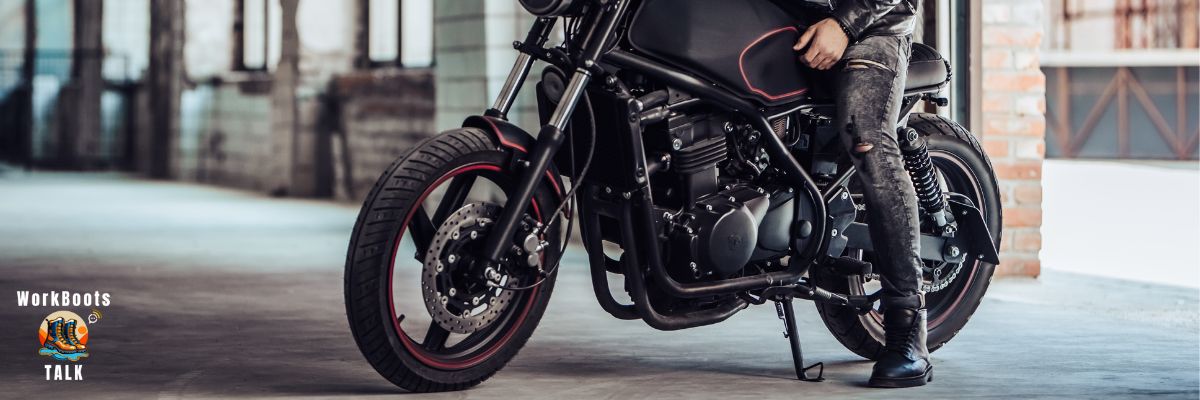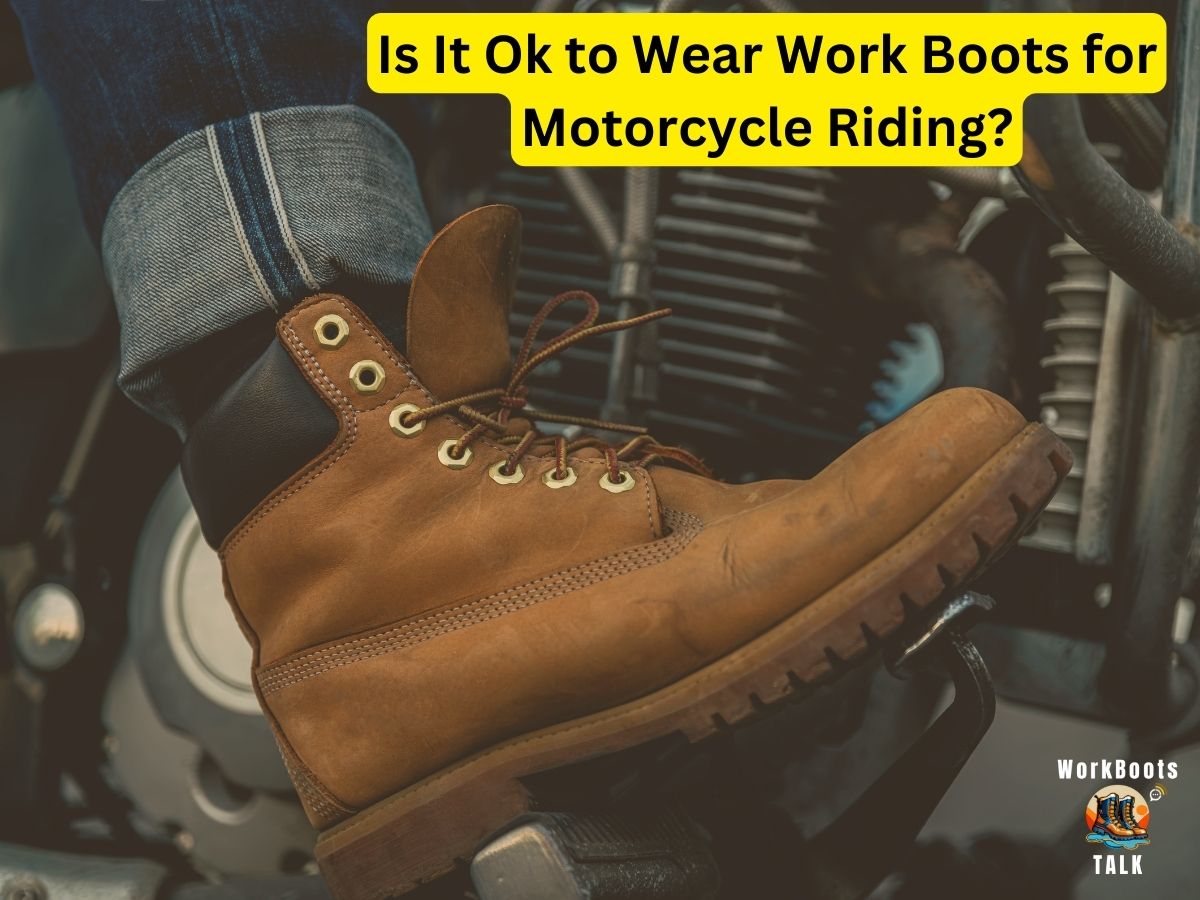If you’re passionate about motorcycles, wearing the appropriate gear, including a motorcycle helmet, motorcycle jacket, and gloves, is vital for your safety and comfort when you’re out on your cruiser or hitting trails with your motocross boots. Yet, the question remains: should you opt for specialized riding shoes such as racing boots and touring boots, or are engineer boots sufficient for your rides?
Choosing between work boots and purpose-designed motorcycle boots involves considering the boot type, your riding activities, and your desired level of protection. This article delves into the advantages and disadvantages of work boots on the road, comparing them to motorcycle boots. We’ll share insights on selecting the best footwear according to your riding habits and preferences.
By the conclusion of this guide, you’ll have a clearer understanding of whether work boots meet the needs of motorcycle riding or if investing in a pair of motorcycle boots is a smarter choice for you.
Understanding the Importance of Proper Motorcycle Footwear
Before diving into the differences between work boots and motorcycle boots, it’s crucial to grasp why selecting the right footwear matters for motorcycling. The reasons boil down to three key areas: injury prevention, durability and longevity, and adaptations to weather and environmental conditions.
Protection Against Injuries
At the forefront, motorcycle footwear aims to shield your feet and ankles from harm in accidents. Research by the National Highway Traffic Safety Administration reveals that lower extremity injuries are most common among riders, making up 30% of all motorcycle-related injuries. These range from minor cuts and scrapes to more severe issues like fractures, dislocations, and even amputations.
To mitigate or lessen these injuries, motorcycle footwear should include:
- Impact protection: Look for shoes with reinforced areas around toes, heels, and ankles that help absorb and distribute force in collisions or falls, along with armour or padding over the shin and calf for added safeguarding.
- Abrasion resistance: Durability is key, so footwear should be crafted from tough materials like leather, synthetic fabrics, and Cordura that resist tearing and wear from pavement friction.
- Stability and support: A snug fit and sturdy sole aid in balance and bike control, with a low heel and rounded toe enhancing gear shifting and braking capabilities.
Durability and Longevity
Wearing proper motorcycle boots also means they’ll serve you longer and perform better. Riding exerts significant stress on footwear through constant exposure to heat, friction, and various substances. Features ensuring longevity include:
- Quality construction: Durable stitching and sealed seams prevent easy wear and tear and from water and dirt penetration. Secure zippers, buckles, and laces are also must-haves.
- Waterproofing and breathability: A membrane that keeps feet dry yet allows them to breathe is essential for comfort across weather conditions, also preventing odour and fungal growth.
- Easy maintenance: Your footwear should be straightforward to clean, requiring only a damp cloth or mild soap, avoiding exposure to harsh conditions to prevent damage.
Weather and Environmental Considerations
The final reason to choose the right motorcycle boots is the ability to adapt to varying weather and the environment. Depending on your riding conditions, you might need different footwear features, such as:
- Temperature and humidity control: Insulation for warmth in cold climates or ventilated designs for cooler feet in heat can make a significant difference.
- Rain and snow readiness: Waterproofing and slip-resistant soles are vital for wet conditions to keep feet dry and maintain traction.
- Dirt and dust resistance: A coating that repels dirt and resists scuffs can keep boots looking good, with taller designs helping prevent debris from entering.

Comparing Work Boots and Motorcycle Boots
Understanding the critical role of appropriate motorcycle footwear, let’s delve into how work boots and motorcycle boots diverge regarding design and construction, impact absorption and ankle support, and traction and slip resistance. These factors are pivotal in determining the efficacy and safety of your footwear while riding.
Differences in Design and Construction
Work boots and motorcycle boots are tailored to meet the demands of their specific uses. Work boots, made from materials like rubber, leather, or synthetics, feature lace-up closures, raised heels, and steel or composite toe caps. In contrast, motorcycle boots are crafted from thick, durable leather, boasting velcro or buckle closures, wide and low heels, and hard upper toes. The notable distinctions include:
- Laces on work boots can become entangled in motorcycle components or loosen during a ride, posing safety risks. Motorcycle boots, with their velcro or buckle closures, offer a more secure and practical solution.
- The raised heels of work boots can interfere with motorcycle foot controls, compromising balance and control. Motorcycle boots, however, come with wide and low heels that ensure better stability and grip.
- While work boots’ steel or composite toe caps safeguard against injuries from falling objects, they might not provide sufficient abrasion or impact protection during a crash. Motorcycle boots, with their hard upper toes, offer enhanced protection against abrasion and impact but might fall short of protecting against crushing injuries.
Impact Absorption and Ankle Support
Crucial for minimizing lower extremity injuries in accidents, impact absorption and ankle support vary significantly between work boots and specialized motorcycle footwear like motocross and Alpinestars boots based on their design and construction. The key distinctions are:
- Work boots, with their thick soles and reinforced toes and heels, can mitigate some impact forces but may not fully prevent fractures or dislocations. Motorcycle boots feature a reinforced sole and a plastic ankle cup offering superior impact force absorption, thus lowering fracture or dislocation risks.
- Offering a snug fit and sturdy sole, work boots provide a degree of stability and support for your ankles, though possibly inadequate in preventing sprains or twists. Motorcycle boots, designed with snug fit and flexing panels, offer enhanced foot and ankle support, safeguarding against sprains or twists.
- The low-top or mid-top designs of work boots may leave ankles vulnerable to abrasion or impact injuries. Motorcycle boots, with their high-top design, provide comprehensive coverage and protection against such injuries.
Traction and Slip Resistance
Essential for maintaining control and grip on your motorcycle and the road, the traction and slip resistance of motorcycle footwear greatly depends on the sole design and material. Here’s how they differ:
- Work boots, featuring rubber or synthetic soles, offer commendable traction and slip resistance on dry, flat surfaces yet may falter on wet or uneven grounds. Motorcycle boots, on the other hand, are equipped with soles that deliver exceptional traction and slip resistance across various surfaces, including wet, uneven terrain and motorcycle foot pegs and controls.
- While the smooth or textured soles of work boots ensure a decent grip and stability, they may not prevent slipping on oily or icy surfaces. Motorcycle boots, with their grooved or patterned soles, provide superior grip and stability, effectively preventing slips and skids on hazardous surfaces.
- Work boots’ flat or curved soles may not adequately distribute pressure or prevent sole and foot control wear and tear. Motorcycle boots, designed with rounded or pointed soles, excel in ensuring optimal contact and pressure distribution, reducing wear and tear on both the sole and the motorcycle’s controls.
When Work Boots Can Be Considered for Motorcycle Riding
While it’s true that work boots and motorcycle boots serve different functions and offer various advantages for riding, it doesn’t necessarily mean you should dismiss work boots altogether for this purpose. In certain conditions, work boots might just fit the bill for motorcycle riding, provided they fulfil some essential criteria. Let’s explore scenarios where work boots could be a viable choice for hitting the road:
Short Trips and Low-Risk Environments
For brief jaunts around the city, such as a commute to work or quick errands, where you’re not tackling rough terrain or extended rides, a pair of sturdy engineer boots might suffice. They can offer ample protection and comfort for these short travels, provided they are fitted with a robust sole and perhaps augmented with a protective insole for comfort. Nonetheless, when venturing on longer rides or off-road adventures, the additional protection from dedicated motorcycle gear like a full-face helmet, a properly fitted motorcycle suit, and armour for critical areas becomes indispensable.
Work Boots with Motorcycle-Specific Features
A select few work boots are crafted with the motorcyclist in mind, incorporating features like velcro or buckle closures, low-profile and wide heels, sturdy upper toes, reinforced soles, and ankle protection. Such boots can provide the protection of a motorcycle suit for your feet and can rival the performance and safety of traditional motorcycle boots, making them a considerable option for riders. Notables among these include Alpinestars and touring boot styles designed to effectively double as work boots, offering versatility for both motorcycle riding and daily tasks.
Custom Modifications to Enhance Safety
Should you have a favoured pair of work boots you’re not ready to replace, you might consider customizing them to better serve your motorcycling needs. You could swap out laces for velcro or buckle fastenings, reinforce the toe and heel regions with extra padding or protective gear, or increase your visibility to other motorists by adding reflective tape or decals to the boots’ exteriors. These tweaks can significantly upgrade your work boots’ security features, impact resistance, and visibility, tailoring them more closely to the demands of motorcycle riding.
Conclusion
This article highlighted the critical importance of choosing the right footwear for motorcycle riding by examining the design, construction, impact absorption, ankle support, and traction differences between work boots and motorcycle boots. Moreover, it offered insights into the specific scenarios in which work boots could suffice for motorcycle riding, alongside suggestions on enhancing their safety and suitability through modifications.
The core message we’ve delivered is the distinct features and advantages that work boots and motorcycle boots offer to riders. It’s essential to pick footwear that aligns with your riding style and preferences. While work boots can be a viable option in certain instances, they generally don’t match the performance and protection provided by motorcycle boots. Therefore, our recommendation leans towards investing in specially designed motorcycle boots, or at the very least, customizing your work boots to improve their compatibility with motorcycle riding requirements.
We trust this article has shed light on the differences between work boots and motorcycle boots, guiding you in choosing the most suitable footwear for your motorcycle adventures. Should you have any questions or wish to share your thoughts, we encourage you to comment below. Thank you for reading, and remember to always ride safely!
Frequently Asked Questions
Q1. Can I use work boots as motorcycle boots?
Yes, you can use work boots as motorcycle boots, but it’s essential to choose ones with proper protection and grip for riding.
Q2. Can I wear regular boots on a motorcycle?
Regular boots can be worn on a motorcycle, but for better safety, it’s recommended to wear boots specifically designed for motorcycle riding.
Q3. Are boots good for motorcycle riding?
The best boots for riding a motorcycle are ones that are specifically designed for motorcycling, with features like sturdy construction, ankle support, non-slip soles, and protection for the toes, heels, and ankles.
Q4. What kind of boots are best for riding a motorcycle?
You can wear motorcycle-specific boots, adventure boots, touring boots, or even some types of work boots that provide adequate protection, grip, and comfort for motorcycle riding.
Q5. Is it hard to ride a motorcycle in steel toe boots?
It’s not necessarily hard to ride a motorcycle in steel toe boots, but it’s essential to ensure that the boots are comfortable and do not hinder your ability to operate the motorcycle’s controls smoothly.
Q6. What shoes can I wear on a motorcycle?
You can wear motorcycle-specific boots, adventure boots, touring boots, or even some types of work boots that provide adequate protection, grip, and comfort for motorcycle riding.

